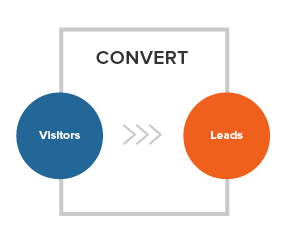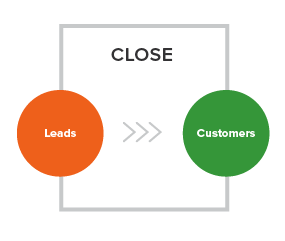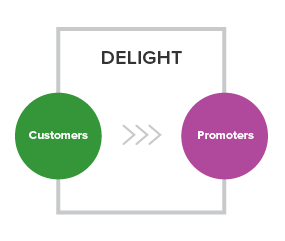
Marketing and sales: is one more important for business growth? It’s an ongoing discussion in the industry. For years sales people have argued they are the most important figures in the business and marketers have claimed that without them sales people are useless.
In 2017, marketing and sales are more competitive (and challenging) than ever. Prospects are tired of aggressive advertising and pushy sales pitches. Poeple are looking to find great products and services that are easy to consume and understand.
Current marketing, or outbound marketing, is the more common marketing approach of the past. Outbound marketing tends to be aggressive and interruptive, putting ads, billboards, and flyers in the faces of potential leads, and can often be irritating instead of attracting.
Digital marketing is already a very crowded space, and because of this consumers are more likely to get annoyed with ads instead of being drawn to them. Not only this, but they now have the ability to easily block ads, or the propensity to ignore them.
And the cherry on top? Data tells us that outbound marketing is actually less effective, yet more expensive.
Inbound marketing focuses on drawing in customers organically – using content that has been designed to solve the needs and questions of your audience. The main principle of inbound marketing is to ‘get found’ by the customer, instead of having to seek them out. When done correctly, your leads will end up on your unique landing page, social media site, etc. – and discover exactly what they’ve been searching for. This method is particularly effective because it helps to quickly build credibility.
The inbound methodology itself is often broken into four marketing actions. We’ll keep it simple:
 1. Attract.
1. Attract.More traffic doesn’t necessarily mean good traffic; we are looking for the right traffic. The right traffic can be defined as our ‘buyer personas’ or, people who are already able to relate to your product or service. They may have similar challenges, needs, questions.
This timeframe is also considered the beginning of the Awareness stage, during which consumers first realize that they have a problem that needs to be solved. From there they move into the Consideration stage, which shifts potential personas towards defining and researching solutions to their problem.
The above stages are part of what we refer to as the “Buyer’s Journey”, and the inbound marketing strategy is built specifically around these, ensuring that the right message is being sent at exactly the right time.
 2. Convert
2. ConvertNow let’s turn those personas into leads. How? Contact information! Methods such as simple forms, or a call to action on your website to get email addresses in exchange for something free – perhaps a helpful PDF, an ebook, etc. The options truly are endless.
 3. Close
3. CloseOK, so you’ve got your leads – now what? Using a variety of tools from Customer Relationship Management (CRM) systems to a series of simple emails, there are plenty of methods to transform your leads into customers. With the inbound marketing methodology you will nurture the leads with more useful content and identify the exact moment they are ready to buy. Only then will you close them as customers without being pushy or aggressive.
 4. Delight
4. DelightIn order to keep those happy customers delighted for life, you can’t just forget about them post-purchase. Keep in touch with your audiences through outlets such as surveys asking for feedback, and social media interactions.
The key to the inbound marketing strategy is that it isn’t just ONE key – it’s a whole bunch that come together to create success. Options range from content marketing, blogs, all forms of social media, organized events, search engine optimization, emails, and so much more. It’s a methodology that earns the attention of potential customers and sets up your company to easily be found – with our help of course.
It’s because of this personalized approach that you then draw in the most likely leads. Odds are that your leads are discovering you because they are already clicking around with questions about your specific industry, or product. This circles back to the concept of ‘earning the attention’ of your customers, instead of screaming at them and begging for attention.
Because let’s be honest, no one likes to be cold-called or approached out of the blue when they’re simply trying to mind their own business. With only 19% of consumers now utilizing salespeople as a resource for their buying decisions, it’s simply an outdated method of the past.
And we have the stats to prove it:
– Two billion people are using Facebook to search for content, daily.
– Four billion people are using messenger apps to communicate and search.
– Two out of three adults use social media to keep up on world events.
– Mobile ad blocking has increased 90% year over year.
(Source)
Now, more than ever, the customers have the power over the ads, not the marketers.
The good news is, we have inbound marketing, a more authentic method that addresses those problems and needs that your potential leads are searching for. And it’s not just about using the right data – it’s about pushing it out at the correct time, in the correct place – so that your leads are delighted instead of irritated
Inbound marketing sets up the relative searches to be lead to you – perhaps your blog, or a recent tweet – in a completely natural and less aggressive way, personalized for the consumer.
An added perk: inbound leads cost roughly 61% less than outbound leads gained through the “louder” methods such as mailings, radio/TV ads, etc.
Let’s run through a real life scenario.
You’re leaving your house in the morning, and decide that you want a coffee on your way to work. Coffee shops using traditional marketing (the outbound method) may still be doing things like mailing coupons to your mailbox, or posting an ad to promote their new coffee shop.
This may have worked years ago. However, in our ever-changing, nonstop digital age, people aren’t pausing to check their mailbox on the way to work, and aren’t reading ads in newspapers or magazines. Where are they looking instead? To search engines on their phones, and to social media for recommendations or interesting content on hot new coffee shops.
Consumers today are more empowered than ever. Essentially any need or question they may have can be found by a simple search on Google, Facebook, and other digital media channels.

Need more reasons as to why inbound is the future of marketing? Check it out:
Don’t get left behind – get on the inbound marketing train. It truly is the future of marketing and sales.
Sources:
https://www.marketo.com/inbound-marketing/ (stats)
https://www.hubspot.com/inbound-marketing (4 actions)
https://blog.hubspot.com/insiders/11-facts-about-inbound-marketing